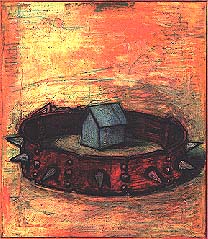

August Issue 2000
Digital Images by Richard Rose at the McKissick Museum
 The Fictional House, an exhibit of works by Richard Rose, Associate Professor
in the Dept. of Art at USC, is on view at the McKissick Museum
in Columbia, SC, through Aug. 27.
The Fictional House, an exhibit of works by Richard Rose, Associate Professor
in the Dept. of Art at USC, is on view at the McKissick Museum
in Columbia, SC, through Aug. 27.
Perhaps more than any other built form, the house is constructed with layers of meaning: utilitarian, domestic, cultural. Its role in literature varies from being a central character to mere shelter, In Michael Cunningham's novel The Hours he writes, "He had a habit of asking about Sally after one of his tirades, as if Sally were some utterly banal safe haven; as if Sally herself (Sally the stoic, the tortured, the subtly wise) were harmless and insipid in the way of a house on a quiet street..." While making drawings of archetypal houses, Rose became intrigued with something else: the house as a metaphor for self. As the drawings evolved, he began combining excerpts from literature, utilizing both traditional media and digital typography. In the present folio of Giclée prints, the images were not conceived as literal illustrations, but rather as an interpretation of theme. In the process Rose found a new appreciation for the relationship between word and image, and is indebted to the writers whose words are quoted in the prints.
In great works of literature, the house sometimes assumes a kind of persona; in a university lecture given on the writing of Charles Dickens, Vladimir Nabokov stated that "things participate- pictures, houses, carriages." The house may also function as a psychological locus, establishing a sense of place in the narrative, or simply as a container for characters' actions, The distinction between inside and outside the house is often analogous to the private/public self. Likewise, the connection between the words "house" and "home" is interesting to consider - though sometimes used interchangeably, their meanings are shaded by circumstances.
As a societal artifact, the house has long served as a visible symbol of social position and material wealth. Although progressive architects such as Le Corbusier and Buckminster Fuller have challenged notions of the conventional house with theoretical ("machine for living") and structural innovations, the current preference in residential America seems to be for familiar styles, outfitted with futuristic appliances, and located in so-called prestige neighborhoods.
The architectural critic Ada Louise Huxtable
rightly observed that we Americans often prefer sanitized history
and fantasy to genuine experience, and in many upscale suburban
communities newness itself serves as a powerful attractant to
potential homeowners. Fueling the myth of the perfect house are
magazines and mail-order catalogues filled with photographs of
"lifestyles," and puffed-up real estate brochures chock
full of curb appeal. As educated consumers, we learn soon enough
how to see through such invitingly varnished windows, and yet,
somehow, we remain receptive to that possibility of a more perfect
habitat.
Unlike the deceptive rhetoric of advertising, the fictional texts
included here are resonant with truths, and invite interpretation
of a wholly different order, Like engaging fragments of overheard
conversations, literary excerpts reveal others' realities, some
of which are recognizable, some evocative of yet other images
- more than once Rose said he thought about Dorothy's spinning
house in the cinematic version of The Wizard of Oz. The
pictorial architecture of Piranesi, de Chirico, Paul Klee, Edward
Hopper, and Lionel Feininger also comes to mind. "While many
artists and architects have given expression to visionary structures,
I sought to imbue these houses with an existential vulnerability.
They are surely not utopian, but are perhaps a touch ironic: lone
and bunker-like, surviving just outside the neighborhood."
For further information check our SC Institutional Gallery listings
or call the museum at 803/777-7251.
Mailing Address: Carolina Arts, P.O. Drawer
427, Bonneau, SC 29431
Telephone, Answering Machine and FAX: 843/825-3408
E-Mail: carolinart@aol.com
Subscriptions are available for $18 a year.
Carolina Arts
is published monthly by Shoestring
Publishing Company, a subsidiary of PSMG, Inc.
Copyright© 2000 by PSMG, Inc., which published Charleston
Arts from July 1987 - Dec. 1994 and South Carolina Arts
from Jan. 1995 - Dec. 1996. It also publishes Carolina Arts
Online, Copyright© 2000 by PSMG, Inc. All rights reserved
by PSMG, Inc. or by the authors of articles. Reproduction or use
without written permission is strictly prohibited. Carolina
Arts is available throughout North & South Carolina.